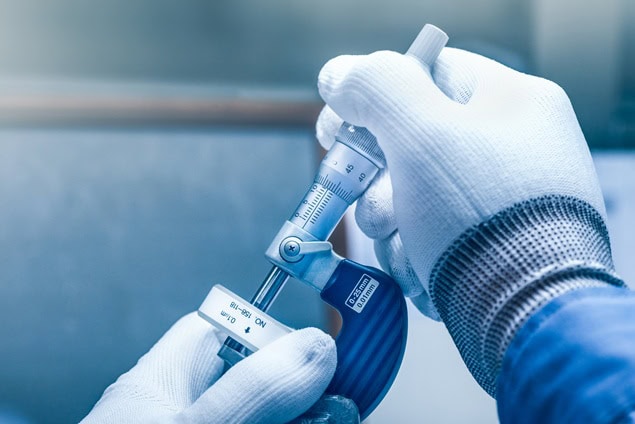21 CFR Part 820 (QSR) Compliance with V5 – Compliant. Controlled. Complete.
V5 from SG Systems Global embeds the FDA Quality System Regulation (QSR, 21 CFR Part 820) directly into day-to-day manufacturing. Instead of treating compliance as paperwork after the fact, V5 enforces it in-process with hard-gated execution, role-based access, electronic signatures, and immutable audit trails. Device Master Records (DMR) drive execution in the shop-floor MES; Device History Records (DHR) are built automatically as operators work; Quality Management workflows (QMS) ensure deviations, CAPA, complaints, and change control move with speed and discipline. The result is faster release, predictable audits, and a defensible quality system that scales from Class I to Class III.
Whether you produce diagnostics, implants, sterile kits, or capital equipment, V5 provides unified control across production, inventory, quality, and distribution. It integrates with your ERP and lab systems, enforces training and calibration prerequisites, and ensures that every material, person, tool, and environment is compliant before work proceeds. No uncontrolled steps. No missing signatures. No guesswork.
“Our FDA inspection was the calmest day of the year. V5 had every DHR, every calibration, every approval sealed and searchable.”
— VP of Quality, Class II Device Manufacturer
How V5 Maps to 21 CFR Part 820
V5 operationalizes the QSR subparts with real-time controls and audit-ready records. The platform aligns your procedures and work instructions to enforced digital steps, turning your quality manual into executable logic:
- Subpart B – Quality System Requirements: Management responsibilities, organization roles, and training are enforced in QMS. Competency is tied to access; expired training blocks regulated tasks until requalification.
- Subpart C – Design Controls: Design history (DHF) artifacts are version-controlled and referenced at release; change control links engineering change orders (ECOs) to training updates and shop-floor instruction revisions.
- Subpart D – Document Controls: SOPs, work instructions, test methods, and forms are revision-controlled with effective/expiry dates, redline visibility, and e-signature approval chains.
- Subpart E – Purchasing Controls: Supplier approval status, incoming inspection plans, and material quarantine are built into WMS. Non-approved or failed lots cannot be released to production.
- Subpart F – Identification & Traceability: Lot/serial tracking is native. Labels, UDI data, and serialization are captured at issue, assembly, and pack; trace queries return backward/forward lineage in seconds.
- Subpart G – Production & Process Controls: MES enforces step sequences, parameters, timers, and in-process checks. Validated ranges and equipment interlocks prevent out-of-spec execution.
- Subpart H – Acceptance Activities: Sampling plans, inspections, and verifications are embedded as gated tasks; results and dispositions flow into DHR and batch release.
- Subpart I – Nonconforming Product: NCR creation, quarantine, review, and disposition (rework, scrap, use-as-is) are workflow-driven with mandatory signatures and justification fields.
- Subpart J – CAPA: Deviations can escalate to CAPA with root-cause tools, corrective/preventive actions, effectiveness checks, and automatic retraining where procedures change.
- Subpart K – Labeling & Packaging Control: Label templates are controlled; print events are logged with lot/serial and revision context. Packaging verification is recorded in DHR.
- Subpart L – Handling, Storage, Distribution, Installation: Controlled storage, FEFO/expiry governance, and installation records are captured and linked to device serialization.
- Subpart M – Records: DMR, DHR, complaint files, servicing records, and audit trails are complete, legible, contemporaneous, original, and attributable—with Part 11-compliant e-signatures.
DMR-Driven Execution; DHR Built Automatically
In V5, the DMR isn’t a binder on a shelf—it’s a living specification that drives execution. Operators see only the current, released instruction set. As each step completes, V5 writes the DHR in real-time with the person, timestamp, equipment status, material lots, environmental readings, and measured results. Change a torque spec, update a test method, or supersede a label artwork and the right people are notified, retrained, and re-authorized before the change goes live.
- Role-Based Access: Training records gate who can perform or verify regulated tasks.
- Material Governance: Only approved lots with passed inspections can be issued; all backflush and scrap are recorded.
- Equipment Integrity: Instruments with overdue calibration or maintenance are auto-blocked; usage counters and meter readings are logged.
- Environmental Capture: Temperature, humidity, differential pressure, or cleanroom status are linked to the DHR where applicable.
- Review by Exception: QA reviewers see a prioritized queue of batches/devices with deviations and holds surfaced automatically.
“The DMR drives the process; the DHR proves it happened—V5 keeps them in lockstep.”
— Director of Manufacturing Engineering
Beyond Minimum Compliance: Controls that Prevent Defects
QSR expects you to design quality into the process. V5 goes further by making quality the default state. Line clearance checklists ensure the right tools and parts are present and the wrong ones are absent. Digital poka-yoke prevents mis-scans and mis-assemblies. Timers and sensors enforce dwell times and torque windows. Where integration exists, V5 can handshake with PLCs and functional testers to record the actual values—not just the box-ticked result.
- Line Clearance & Setup Verification: Area readiness must be confirmed before start.
- eBR/eDHR Step Enforcement: Each step has acceptance criteria, witnesses, and signatures as needed.
- Real-Time Holds: Deviations, OOT data, or failed inspections place automatic QA holds.
- Complaint & Post-Market Links: Complaint trending can trigger CAPA and retraining.
- Analytics & KPIs: First-pass yield, escape rates, defects by component, and CAPA cycle time are tracked and trended.
Part 11, Validation, and Change Control
V5 supports Part 11-compliant electronic signatures and audit trails so records are attributable and tamper-evident. The platform is delivered with validation documentation aligned to GAMP principles, and our teams work with your CSV/CSA approach to right-size the testing burden. Change control connects document revisions to retraining and re-authorization, ensuring no one executes against obsolete instructions.
- Electronic Signatures: Unique IDs, password controls, and signature meaning capture.
- Audit Trails: Immutable, time-stamped, user-attributed events with pre/post values.
- Validation Support: Risk-based validation documentation package available.
- Controlled Releases: Effective dating, staged rollouts, and forced acknowledgement for operators.
Integrations, Deployment Options, and Scalability
V5 connects to ERP, PLM, LIMS, label systems, test stands, and shop-floor equipment to minimize double entry and maximize confidence. Deploy on-prem or in the cloud; control data residency and access with granular permissions and SSO. Start with a pilot line, scale to multiple facilities, and maintain a single source of truth throughout the product lifecycle.
- ERP/WMS/PLM: Master data sync, work orders, and serial/UDI flows remain consistent across systems.
- Testing & Metrology: Import measurements automatically; block release on failure.
- Labels & UDI: Template control and print event capture integrated to DHR.
- Cloud or On-Prem: Secure, validated configurations for regulated environments.
For Medical Device Manufacturers
Explore how V5 is tailored for device makers—from sub-assembly to final pack—across cleanrooms, machining cells, electronics, and sterile processing. Our solution overview for the sector is here:
Medical Device Manufacturing with V5.
What You’ll See in an FDA Inspection with V5
- Instant DHR Retrieval: Search by serial, lot, work order, or UDI to display the complete record—including materials, tests, signatures, and label events.
- Calibration Proof: Any instrument used in production links to its calibration record with status at time-of-use.
- Training Proof: Each operator’s training matrix shows they were qualified on the effective revision when they signed.
- Deviation/CAPA Story: Deviations are traceable to root cause, corrective actions, and effectiveness checks; linked retraining is visible.
- Document Control: Released versions, redlines, and approval signatures are one click away.
Measured Outcomes
Teams running V5 report fewer escapes, cleaner audits, and shorter cycle times to release. More importantly, they stop relying on heroic effort to “pull the record together” and instead rely on a system that makes the right way the only way. That translates into better margins, fewer write-offs, and more capacity for new product introductions without risking compliance debt.
- Release Time: Review-by-exception reduces QA effort on conforming lots.
- Right-First-Time: Parameter gating and verification reduce rework and scrap.
- Audit Readiness: Records are contemporaneous and complete—no scramble.
- Scalable Governance: Multi-site standardization without losing local control.
Modules That Power QSR Compliance
- MES – Step enforcement, data capture, timers, witnesses, and e-signatures form the eDHR.
- WMS – Supplier status, quarantine, FEFO/expiry, kitting accuracy, and serial/lot control.
- QMS – Document control, training, deviations, CAPA, complaints, change control, and audits.
With V5, 21 CFR Part 820 compliance isn’t a separate project—it’s how you run production. Build quality in, prove it continuously, and be inspection-ready every day.



